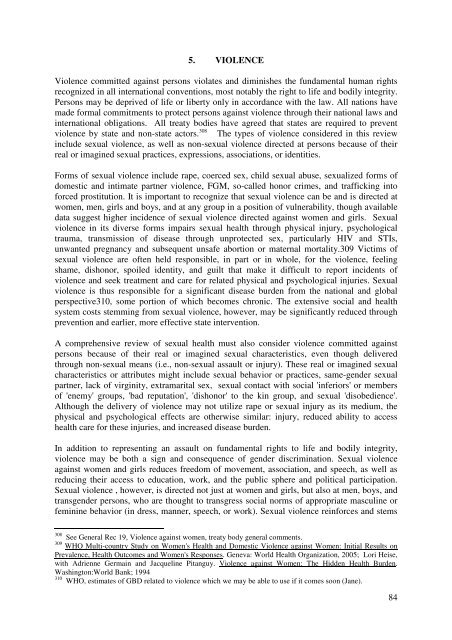SEXUAL HEALTH AND HUMAN RIGHTS A legal and ... - The ICHRP
SEXUAL HEALTH AND HUMAN RIGHTS A legal and ... - The ICHRP
SEXUAL HEALTH AND HUMAN RIGHTS A legal and ... - The ICHRP
Create successful ePaper yourself
Turn your PDF publications into a flip-book with our unique Google optimized e-Paper software.
5. VIOLENCE<br />
Violence committed against persons violates <strong>and</strong> diminishes the fundamental human rights<br />
recognized in all international conventions, most notably the right to life <strong>and</strong> bodily integrity.<br />
Persons may be deprived of life or liberty only in accordance with the law. All nations have<br />
made formal commitments to protect persons against violence through their national laws <strong>and</strong><br />
international obligations. All treaty bodies have agreed that states are required to prevent<br />
violence by state <strong>and</strong> non-state actors. 308 <strong>The</strong> types of violence considered in this review<br />
include sexual violence, as well as non-sexual violence directed at persons because of their<br />
real or imagined sexual practices, expressions, associations, or identities.<br />
Forms of sexual violence include rape, coerced sex, child sexual abuse, sexualized forms of<br />
domestic <strong>and</strong> intimate partner violence, FGM, so-called honor crimes, <strong>and</strong> trafficking into<br />
forced prostitution. It is important to recognize that sexual violence can be <strong>and</strong> is directed at<br />
women, men, girls <strong>and</strong> boys, <strong>and</strong> at any group in a position of vulnerability, though available<br />
data suggest higher incidence of sexual violence directed against women <strong>and</strong> girls. Sexual<br />
violence in its diverse forms impairs sexual health through physical injury, psychological<br />
trauma, transmission of disease through unprotected sex, particularly HIV <strong>and</strong> STIs,<br />
unwanted pregnancy <strong>and</strong> subsequent unsafe abortion or maternal mortality.309 Victims of<br />
sexual violence are often held responsible, in part or in whole, for the violence, feeling<br />
shame, dishonor, spoiled identity, <strong>and</strong> guilt that make it difficult to report incidents of<br />
violence <strong>and</strong> seek treatment <strong>and</strong> care for related physical <strong>and</strong> psychological injuries. Sexual<br />
violence is thus responsible for a significant disease burden from the national <strong>and</strong> global<br />
perspective310, some portion of which becomes chronic. <strong>The</strong> extensive social <strong>and</strong> health<br />
system costs stemming from sexual violence, however, may be significantly reduced through<br />
prevention <strong>and</strong> earlier, more effective state intervention.<br />
A comprehensive review of sexual health must also consider violence committed against<br />
persons because of their real or imagined sexual characteristics, even though delivered<br />
through non-sexual means (i.e., non-sexual assault or injury). <strong>The</strong>se real or imagined sexual<br />
characteristics or attributes might include sexual behavior or practices, same-gender sexual<br />
partner, lack of virginity, extramarital sex, sexual contact with social 'inferiors' or members<br />
of 'enemy' groups, 'bad reputation', 'dishonor' to the kin group, <strong>and</strong> sexual 'disobedience'.<br />
Although the delivery of violence may not utilize rape or sexual injury as its medium, the<br />
physical <strong>and</strong> psychological effects are otherwise similar: injury, reduced ability to access<br />
health care for these injuries, <strong>and</strong> increased disease burden.<br />
In addition to representing an assault on fundamental rights to life <strong>and</strong> bodily integrity,<br />
violence may be both a sign <strong>and</strong> consequence of gender discrimination. Sexual violence<br />
against women <strong>and</strong> girls reduces freedom of movement, association, <strong>and</strong> speech, as well as<br />
reducing their access to education, work, <strong>and</strong> the public sphere <strong>and</strong> political participation.<br />
Sexual violence , however, is directed not just at women <strong>and</strong> girls, but also at men, boys, <strong>and</strong><br />
transgender persons, who are thought to transgress social norms of appropriate masculine or<br />
feminine behavior (in dress, manner, speech, or work). Sexual violence reinforces <strong>and</strong> stems<br />
308 See General Rec 19, Violence against women, treaty body general comments.<br />
309 WHO Multi-country Study on Women's Health <strong>and</strong> Domestic Violence against Women: Initial Results on<br />
Prevalence, Health Outcomes <strong>and</strong> Women's Responses. Geneva: World Health Organization, 2005; Lori Heise,<br />
with Adrienne Germain <strong>and</strong> Jacqueline Pitanguy. Violence against Women: <strong>The</strong> Hidden Health Burden.<br />
Washington:World Bank; 1994<br />
310 WHO, estimates of GBD related to violence which we may be able to use if it comes soon (Jane).<br />
84

















